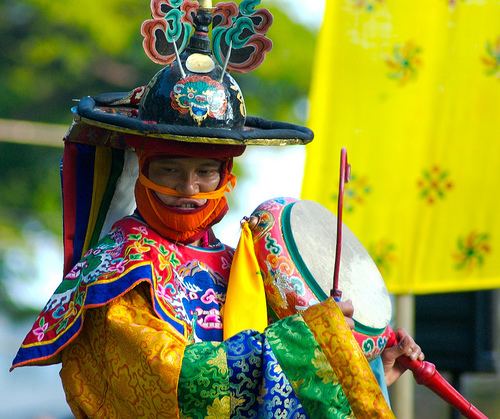 | ||
The cham dance (Tibetan: འཆམ་, Wylie: 'cham; Chinese: 跳欠; pinyin: tiàoqiàn), is a lively masked and costumed dance associated with some sects of Tibetan Buddhism and Buddhist festivals. The dance is accompanied by music played by monks using traditional Tibetan instruments. The dances often offer moral instruction relating to compassion for sentient beings and are held to bring merit to all who perceive them.
Contents
Cham dances are considered a form of meditation and an offering to the gods. The leader of the cham is typically a musician, keeping time using some percussion instrument like cymbals, the one exception being Dramyin Cham, where time is kept using dramyin.
Cham content
Chams often depict incidents from the life of Padmasambhava, the 9th century Nyingmapa teacher, and other saints.
The great debate of the Council of Lhasa between the two principal debators or dialecticians, Moheyan and Kamalaśīla is narrated and depicted in a specific cham dance once held annually at Kumbum Monastery in Qinghai.
Bhutan
In Bhutan, the dances are performed during an annual religious festival known as Tshechu, which is held in each district. The Cham are performed by monks, nuns, and villagers. The Royal Academy of Performing Arts are the main body which emphasize on preservation of culture of Cham and dances.
Tibet
Tibetans usually perform the cham dance to large audiences during the Monlam Prayer Festival.
India
Dances are performed in Sikkim, Dharamsala and Ladakh during cultural and religious festivals.
